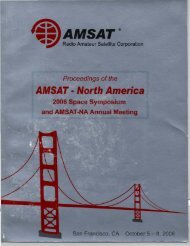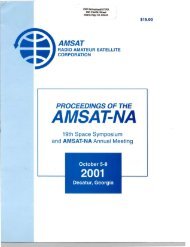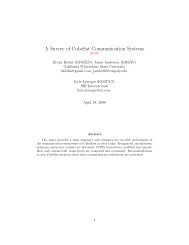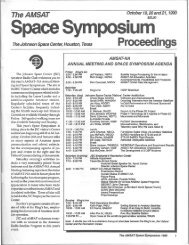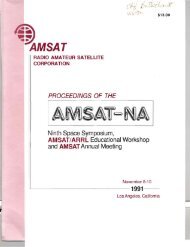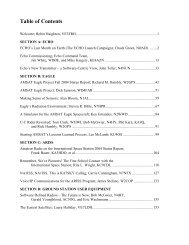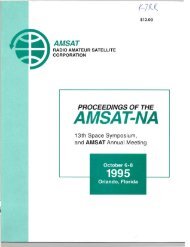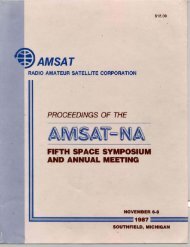October 27-29, 2000 - Klofas.com
October 27-29, 2000 - Klofas.com
October 27-29, 2000 - Klofas.com
You also want an ePaper? Increase the reach of your titles
YUMPU automatically turns print PDFs into web optimized ePapers that Google loves.
6. CONCLUSIONS <br />
The OPAL program demonstrated that a low cost launch system could be used to launch picosatellites. The success<br />
of The Aerospace Corporation picosatellites demonstrated the frrst use ofthese picosatellites. The new picosatellite,<br />
CubeSat, now proposed as a standard that can be launched with the launcher tube developed by Cal Poly, the P-POD<br />
will provide low cost opportunities for a new era in space experimentation.<br />
These new CubeSats and the low cost make it practical for even universities and private groups such as amateur<br />
radio clubs to have access to space. The future of these space devices based on the CubeSat design will now depend<br />
upon how innovative the science and general <strong>com</strong>munity can be.<br />
An equitable solution to the frequency allocation problem must be a mutually solved problem by both the AMSAT<br />
and the CubeSat <strong>com</strong>munity or they both will suffer in their program objective.<br />
7. ACKNOWLEDGEMENTS<br />
The initiation of the mother/daughter picosatellite work started at Stanford was done through the work of Professor<br />
Tom Kenny in the Stanford mechanical engineering department and Mr. Jim Randolf at the Jet Propulsion<br />
Laboratory. The fmal push to meet OPAL's mission was due to Ernie Robinson at The Aerospace Corporation and<br />
Al Pisano, the director of the MEMS activity at DARPA.<br />
Many students at Stanford worked very long and hard at <strong>com</strong>pleting SAPPHIRE, which was the predecessor to<br />
OPAL, and OPAL. Foremost ofthese students supporting SAPPHIRE over several years were Mike Swartwout and<br />
Chris Kitts. The OPAL effort was led initially by Brian Engberg, Clem Tillier and Carlos Niederstrasser and fmally<br />
by Jamie Cutler and Greg Hutchins. These two projects had more than one hundred students work on them over a<br />
five year period. SSDL has outstanding mentors group to support students in their work with much volunteer effort<br />
from John Ellis, Lars Karlsson, Dick Kors, Ron Ross, Richard Anderson and David Joseph to name a few.<br />
Boeing, DARPA, NASA Ames Research Center, NASA Langley and Jet Propulsion Laboratory provided research<br />
support for SSDL. Lockheed Martin, Space Systems/Loral, Deskin Research and The Aerospace Corporation<br />
provided additional financial and facilities support.<br />
The CubeSat program as done in collaboration with Prof. Jordi Puig-Suari at Cal Poly demonstrates the motivation<br />
that a space program can bring to education. The Cal Poly students like Ryan Connelly and Jeremy Schoos are<br />
examples of students excited, enthusiastic and motivated by their education. These students are the most valuable<br />
output of these programs.<br />
8. REFERNCES<br />
1 "Picosat Free Flying Magnetometer Experiment", Clarke, D.S., M.T. Hicks, A.M. Fitzgerald, U. Suchman, R<br />
Twiggs, T.W. Kenny, and J. Randolf, June 15, 1996, Proceedings of the Tenth Annual AIAAIUSU Small<br />
Satellite Conference, September 16-19, 1996. Presented by Michael T. Hicks at the Tenth Annual AIAAlUSU<br />
Small Satellite Conference, New Missions I Session. Logan, UT, September 16, 1996<br />
2 "On-orbit Dynamics and New Control Scheme for Large Membrane "Furoshiki" Satellite", Motohashi, S.,<br />
Nakasuka, S., Aoki, T., Narusawa, Y., Nagashima, R, Kawakatsu, Y. and Kinoshita, T.,. Proceedings of 21st<br />
ISTS, 98-e-20, 1998<br />
3 "Behavior of Membrane Structure under Microgravity Environment", Narusawa, Y., Aoki, T., Nakasuka, S.,<br />
Motohashi, S., Nagashirna, R, Kawakatsu, Y. and Kinoshita, T., Proceedings of21st ISTS, 98-b-16, 1998<br />
4 "On-orbit Dynamics and Control of Large Scaled Membrane with Satellites at its Comers", Motohashi, S.,<br />
Nakasuka, S., Proceedings ofIFAC Symposium on Aerospace Control, pp. 146-151, 1998<br />
37



